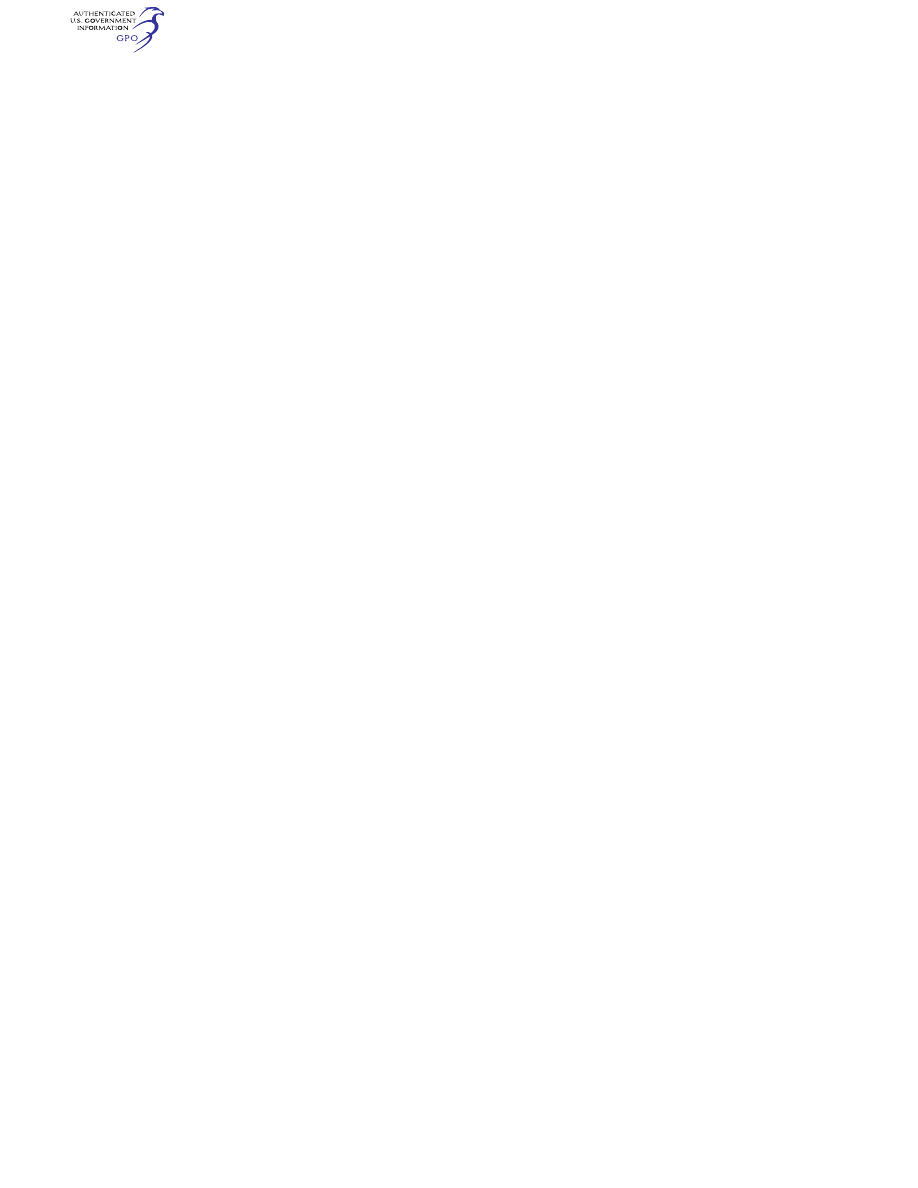
672
14 CFR Ch. I (1–1–24 Edition)
§ 29.1509
§ 29.1509
Rotor speed.
(a)
Maximum power-off (autorotation).
The maximum power-off rotor speed
must be established so that it does not
exceed 95 percent of the lesser of—
(1) The maximum design r.p.m. deter-
mined under § 29.309(b); and
(2) The maximum r.p.m. shown dur-
ing the type tests.
(b)
Minimum power-off. The minimum
power-off rotor speed must be estab-
lished so that it is not less than 105
percent of the greater of—
(1) The minimum shown during the
type tests; and
(2) The minimum determined by de-
sign substantiation.
(c)
Minimum power-on. The minimum
power-on rotor speed must be estab-
lished so that it is—
(1) Not less than the greater of—
(i) The minimum shown during the
type tests; and
(ii) The minimum determined by de-
sign substantiation; and
(2) Not more than a value determined
under § 29.33 (a)(1) and (c)(1).
§ 29.1517
Limiting height-velocity en-
velope.
For Category A rotorcraft, if a range
of heights exists at any speed, includ-
ing zero, within which it is not possible
to make a safe landing following power
failure, the range of heights and its
variation with forward speed must be
established, together with any other
pertinent information, such as the kind
of landing surface.
[Amdt. 29–21, 48 FR 4391, Jan. 31, 1983, as
amended by Amdt. 29–59, 88 FR 8739, Feb. 10,
2023]
§ 29.1519
Weight and center of gravity.
The weight and center of gravity lim-
itations determined under §§ 29.25 and
29.27, respectively, must be established
as operating limitations.
§ 29.1521
Powerplant limitations.
(a)
General. The powerplant limita-
tions prescribed in this section must be
established so that they do not exceed
the corresponding limits for which the
engines are type certificated.
(b)
Takeoff operation. The powerplant
takeoff operation must be limited by—
(1) The maximum rotational speed,
which may not be greater than—
(i) The maximum value determined
by the rotor design; or
(ii) The maximum value shown dur-
ing the type tests;
(2) The maximum allowable manifold
pressure (for reciprocating engines);
(3) The maximum allowable turbine
inlet or turbine outlet gas temperature
(for turbine engines);
(4) The maximum allowable power or
torque for each engine, considering the
power input limitations of the trans-
mission with all engines operating;
(5) The maximum allowable power or
torque for each engine considering the
power input limitations of the trans-
mission with one engine inoperative;
(6) The time limit for the use of the
power corresponding to the limitations
established in paragraphs (b)(1)
through (5) of this section; and
(7) If the time limit established in
paragraph (b)(6) of this section exceeds
2 minutes—
(i) The maximum allowable cylinder
head or coolant outlet temperature (for
reciprocating engines); and
(ii) The maximum allowable engine
and transmission oil temperatures.
(c)
Continuous operation. The contin-
uous operation must be limited by—
(1) The maximum rotational speed,
which may not be greater than—
(i) The maximum value determined
by the rotor design; or
(ii) The maximum value shown dur-
ing the type tests;
(2) The minimum rotational speed
shown under the rotor speed require-
ments in § 29.1509(c).
(3) The maximum allowable manifold
pressure (for reciprocating engines);
(4) The maximum allowable turbine
inlet or turbine outlet gas temperature
(for turbine engines);
(5) The maximum allowable power or
torque for each engine, considering the
power input limitations of the trans-
mission with all engines operating;
(6) The maximum allowable power or
torque for each engine, considering the
power input limitations of the trans-
mission with one engine inoperative;
and
(7) The maximum allowable tempera-
tures for—
VerDate Sep<11>2014
09:06 Jun 28, 2024
Jkt 262046
PO 00000
Frm 00682
Fmt 8010
Sfmt 8010
Y:\SGML\262046.XXX
262046
jspears on DSK121TN23PROD with CFR

673
Federal Aviation Administration, DOT
§ 29.1521
(i) The cylinder head or coolant out-
let (for reciprocating engines);
(ii) The engine oil; and
(iii) The transmission oil.
(d)
Fuel grade or designation. The min-
imum fuel grade (for reciprocating en-
gines) or fuel designation (for turbine
engines) must be established so that it
is not less than that required for the
operation of the engines within the
limitations in paragraphs (b) and (c) of
this section.
(e)
Ambient temperature. Ambient
temperature limitations (including
limitations for winterization installa-
tions if applicable) must be established
as the maximum ambient atmospheric
temperature at which compliance with
the cooling provisions of §§ 29.1041
through 29.1049 is shown.
(f)
Two and one-half minute OEI power
operation. Unless otherwise authorized,
the use of 2
1
⁄
2
-minute OEI power must
be limited to engine failure operation
of multiengine, turbine-powered rotor-
craft for not longer than 2
1
⁄
2
minutes
for any period in which that power is
used. The use of 2
1
⁄
2
-minute OEI power
must also be limited by—
(1) The maximum rotational speed,
which may not be greater than—
(i) The maximum value determined
by the rotor design; or
(ii) The maximum value shown dur-
ing the type tests;
(2) The maximum allowable gas tem-
perature;
(3) The maximum allowable torque;
and
(4) The maximum allowable oil tem-
perature.
(g)
Thirty-minute OEI power operation.
Unless otherwise authorized, the use of
30-minute OEI power must be limited
to multiengine, turbine-powered rotor-
craft for not longer than 30 minutes
after failure of an engine. The use of 30-
minute OEI power must also be limited
by—
(1) The maximum rotational speed,
which may not be greater than—
(i) The maximum value determined
by the rotor design; or
(ii) The maximum value shown dur-
ing the type tests;
(2) The maximum allowable gas tem-
perature;
(3) The maximum allowable torque;
and
(4) The maximum allowable oil tem-
perature.
(h)
Continuous OEI power operation.
Unless otherwise authorized, the use of
continuous OEI power must be limited
to multiengine, turbine-powered rotor-
craft for continued flight after failure
of an engine. The use of continuous
OEI power must also be limited by—
(1) The maximum rotational speed,
which may not be greater than—
(i) The maximum value determined
by the rotor design; or
(ii) The maximum value shown dur-
ing the type tests.
(2) The maximum allowable gas tem-
perature;
(3) The maximum allowable torque;
and
(4) The maximum allowable oil tem-
perature.
(i)
Rated 30-second OEI power oper-
ation. Rated 30-second OEI power is
permitted only on multiengine, tur-
bine-powered rotorcraft, also certifi-
cated for the use of rated 2-minute OEI
power, and can only be used for contin-
ued operation of the remaining en-
gine(s) after a failure or precautionary
shutdown of an engine. It must be
shown that following application of 30-
second OEI power, any damage will be
readily detectable by the applicable in-
spections and other related procedures
furnished in accordance with Section
A29.4 of appendix A of this part and
Section A33.4 of appendix A of part 33.
The use of 30-second OEI power must be
limited to not more than 30 seconds for
any period in which that power is used,
and by—
(1) The maximum rotational speed
which may not be greater than—
(i) The maximum value determined
by the rotor design; or
(ii) The maximum value dem-
onstrated during the type tests;
(2) The maximum allowable gas tem-
perature; and
(3) The maximum allowable torque.
(j)
Rated 2-minute OEI power oper-
ation. Rated 2-minute OEI power is per-
mitted only on multiengine, turbine-
powered rotorcraft, also certificated
for the use of rated 30-second OEI
power, and can only be used for contin-
ued operation of the remaining en-
gine(s) after a failure or precautionary
shutdown of an engine. It must be
VerDate Sep<11>2014
09:06 Jun 28, 2024
Jkt 262046
PO 00000
Frm 00683
Fmt 8010
Sfmt 8010
Y:\SGML\262046.XXX
262046
jspears on DSK121TN23PROD with CFR

674
14 CFR Ch. I (1–1–24 Edition)
§ 29.1522
shown that following application of 2-
minute OEI power, any damage will be
readily detectable by the applicable in-
spections and other related procedures
furnished in accordance with Section
A29.4 of appendix a of this part and
Section A33.4 of appendix A of part 33.
The use of 2-minute OEI power must be
limited to not more than 2 minutes for
any period in which that power is used,
and by—
(1) The maximum rotational speed,
which may not be greater than—
(i) The maximum value determined
by the rotor design; or
(ii) The maximum value dem-
onstrated during the type tests;
(2) The maximum allowable gas tem-
perature; and
(3) The maximum allowable torque.
(Secs. 313(a), 601, 603, 604, and 605 of the Fed-
eral Aviation Act of 1958 (49 U.S.C. 1354(a),
1421, 1423, 1424, and 1425); and sec. 6(c), Dept.
of Transportation Act (49 U.S.C. 1655(c)))
[Doc. No. 5084, 29 FR 16150, Dec. 3, 1964, as
amended by Amdt. 29–1, 30 FR 8778, July 13,
1965; Amdt. 29–3, 33 FR 971, Jan. 26, 1968;
Amdt. 29–15, 43 FR 2327, Jan. 16, 1978; Amdt.
29–26, 53 FR 34220, Sept. 2, 1988; Amdt. 29–34,
59 FR 47768, Sept. 16, 1994; Amdt. 29–41, 62 FR
46173, Aug. 29, 1997]
§ 29.1522
Auxiliary power unit limita-
tions.
If an auxiliary power unit that meets
the requirements of TSO-C77 is in-
stalled in the rotorcraft, the limita-
tions established for that auxiliary
power unit under the TSO including
the categories of operation must be
specified as operating limitations for
the rotorcraft.
(Secs. 313(a), 601, 603, 604, Federal Aviation
Act of 1958 (49 U.S.C. 1354(a), 1421, 1423), sec.
6(c), Dept. of Transportation Act (49 U.S.C.
1655(c)))
[Amdt. 29–17, 43 FR 50602, Oct. 30, 1978]
§ 29.1523
Minimum flight crew.
The minimum flight crew must be es-
tablished so that it is sufficient for safe
operation, considering—
(a) The workload on individual crew-
members;
(b) The accessibility and ease of oper-
ation of necessary controls by the ap-
propriate crewmember; and
(c) The kinds of operation authorized
under § 29.1525.
§ 29.1525
Kinds of operations.
The kinds of operations (such as
VFR, IFR, day, night, or icing) for
which the rotorcraft is approved are es-
tablished by demonstrated compliance
with the applicable certification re-
quirements and by the installed equip-
ment.
[Amdt. 29–24, 49 FR 44440, Nov. 6, 1984]
§ 29.1527
Maximum operating altitude.
The maximum altitude up to which
operation is allowed, as limited by
flight, structural, powerplant, func-
tional, or equipment characteristics,
must be established.
(Secs. 313(a), 601, 603, 604, and 605 of the Fed-
eral Aviation Act of 1958 (49 U.S.C. 1354(a),
1421, 1423, 1424, and 1425); and sec. 6(c), Dept.
of Transportation Act (49 U.S.C. 1655(c)))
[Amdt. 29–15, 43 FR 2327, Jan. 16, 1978]
§ 29.1529
Instructions for Continued
Airworthiness.
The applicant must prepare Instruc-
tions for Continued Airworthiness in
accordance with appendix A to this
part that are acceptable to the Admin-
istrator. The instructions may be in-
complete at type certification if a pro-
gram exists to ensure their completion
prior to delivery of the first rotorcraft
or issuance of a standard certificate of
airworthiness, whichever occurs later.
[Amdt. 29–20, 45 FR 60178, Sept. 11, 1980]
M
ARKINGS AND
P
LACARDS
§ 29.1541
General.
(a) The rotorcraft must contain—
(1) The markings and placards speci-
fied in §§ 29.1545 through 29.1565; and
(2) Any additional information, in-
strument markings, and placards re-
quired for the safe operation of the
rotorcraft if it has unusual design, op-
erating or handling characteristics.
(b) Each marking and placard pre-
scribed in paragraph (a) of this sec-
tion—
(1) Must be displayed in a con-
spicuous place; and
(2) May not be easily erased, dis-
figured, or obscured.
§ 29.1543
Instrument markings: gen-
eral.
For each instrument—
VerDate Sep<11>2014
09:06 Jun 28, 2024
Jkt 262046
PO 00000
Frm 00684
Fmt 8010
Sfmt 8010
Y:\SGML\262046.XXX
262046
jspears on DSK121TN23PROD with CFR


